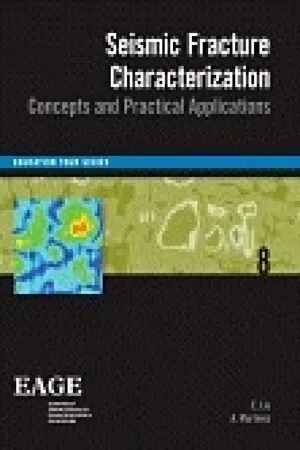
- 280 pages
- English
- PDF
- Available on iOS & Android
About this book
During the last three decades, seismic anisotropy has evolved from a purely academic research topic into applications in the mainstream of applied geophysics. Today, nobody doubts that the earth is anisotropic and most (if not all) hydrocarbon reservoirs are anisotropic. Since shale accounts for 70% of sedimentary basins and fractures exist in all reservoirs, seismic anisotropy may be even more extensive than we think. Taking anisotropy into account in seismic processing has improved the quality of seismic images, even though it makes seismic processing more challenging since additional parameters are needed. At the same time, fracture characterization using the concept of seismic anisotropy has added value in reservoir characterization, reservoir management, and has increased recovery and optimized well locations. This book and the associated course provide an introduction to the fundamental concepts of seismic fracture characterization by introducing seismic anisotropy, equivalent-medium representation theories of fractured rock and methodologies for extracting fracture parameters from seismic data. We focus on practical applications using extensive field data examples.- Includes cast studies demonstrating the applicability, workflow and limitations of this technology- Contains physical laboratory 3D experiments where fracture distributions are known, a Middle East fractured carbonate reservoir and a fractured tight gas reservoir.- Builds discrete fracture network models incorporating all data. These models should not only be geologically consistent but also geophysically and geomechanically consistent, so that the models can be used to forecast the behaviour and performance of fractured reservoirs.
Frequently asked questions
- Essential is ideal for learners and professionals who enjoy exploring a wide range of subjects. Access the Essential Library with 800,000+ trusted titles and best-sellers across business, personal growth, and the humanities. Includes unlimited reading time and Standard Read Aloud voice.
- Complete: Perfect for advanced learners and researchers needing full, unrestricted access. Unlock 1.4M+ books across hundreds of subjects, including academic and specialized titles. The Complete Plan also includes advanced features like Premium Read Aloud and Research Assistant.
Please note we cannot support devices running on iOS 13 and Android 7 or earlier. Learn more about using the app.
Information
Table of contents
- Front Cover
- Seismic Fracture Characterization: Concepts and Practical Applications
- Copyright Page
- Table of Contents
- Acknowledgements
- General disclaimer
- Preface
- Chapter 1. Introduction
- Chapter 2. Fundamentals of seismic anisotropy
- Chapter 3. Equivalent medium modelling of fractured rock
- Chapter 4. Estimation of fracture parameters from azimuthal analysis of P-wave data
- Chapter 5. Multicomponent seismology and its application to fracture characterization
- Chapter 6. Fracture detection using 3D seismic data: physical laboratory studies
- Chapter 7. Mitigation of overburden effects in azimuthal AVO analysis of a Middle East carbonate field
- Chapter 8. Integrated study of fracture characterization of a tight gas reservoir using 3C-3D seismic data at Piceance Basin, Colorado, USA
- Chapter 9. Summary and road ahead
- References
- Appendix A: The two-index notation of elastic tensors
- Appendix B: Wave propagation in anisotropic media
- Appendix C: Effective elastic constants of cracked media – Hudson’s model
- Appendix D: Plane wave reflection and transmission coefficients in anisotropic media – Schoenberg and Protazio algorithm
- Index